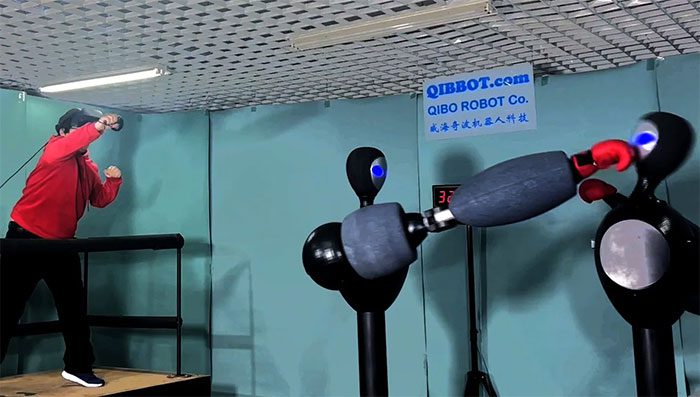The Qibbot robot can be controlled remotely with a response delay of only 12 milliseconds, less than 1/15th of the time it takes to blink.
Qibo Robot, a company based in Shandong Province, eastern China, has developed the Qibbot, a one-armed remote-controlled robot designed to mimic the real movements of a fighter, as reported by SCMP on August 3rd. The operator of the Qibbot can stand nearby and control its actions just like a coach in the ring.
Remote-controlled robot Qibbot. (Video: Qibbot).
In a video shared by Qibo, the Qibbot demonstrates an impressive response delay of just 12 milliseconds, a record for remote-controlled robotic systems. Qibo Robot claims that this is the “fastest telerobot (remote-controlled robot) in the world.”
The main technical challenge with high-speed remote-controlled robots is not their speed but the response capability related to the operator’s actions. In situations like sports competitions, crime prevention, and military operations, the response time of the robot is critically important. Even the slightest delay can lead to significant consequences.
According to Geng Tao, the founder of Qibo Robot, more than 95% of remote-controlled robots worldwide are designed for low to medium-speed tasks, often exhibiting significant response delays that exceed 100 milliseconds.
The Qibbot features an extremely low delay of just 12 milliseconds during high-speed operations, which is less than 1/15th of the time it takes to blink, Geng noted. This means that the operator is unlikely to perceive any delay.
Remote-controlled robots rely on numerous factors to optimize speed and performance. To achieve impressive speed and extremely low latency, the expert team at Qibbot focused on addressing challenges related to mechanics and controllers.

Qibbot has an extremely low delay of just 12 milliseconds during high-speed operations.
With Qibbot’s control algorithm, Geng and his colleagues used a new predictive controller along with a standard feedback controller. This real-time predictive tool anticipates the system’s delay and responds in advance, compensating for some of the delay caused by mechanical systems and virtual reality equipment.
Worldwide, only a few robots have achieved rapid remote control capabilities with extremely low latency, but they tend to be small and require highly complex remote control devices. In contrast, the Qibbot stands 1.9 meters tall with a 1.5-meter arm, and the single-arm version weighs up to 140 kilograms.
The Qibbot project began in 2019, and the team of experts spent three years developing the first-generation model. They then spent an additional year refining it before launching the Qibbot in June.
Geng’s team plans to create an upgraded version of the Qibbot by the end of this year, featuring two arms, each with more joints and smoother movements. They believe that fast-moving remote-controlled robots have the potential for applications in various emergency and hazardous situations, such as crime prevention and military operations, while significantly enhancing production efficiency.


















































